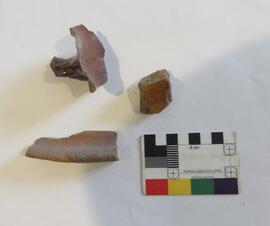F.07: this contained a sherd of 16th to 17th century glazed red earthenware (66g).
Some butchery
English stoneware
Contained ten sherds, nine of which are from one vessel. The vessel represented by nine sherds (206g) from [001] is in a hard, reduced fabric with common fine to medium sand and sparse voids from plant material. Most of the sherd edges are very fresh showing breakage upon excavation. Five of the sherds refit to form a substantial rim and wall fragment, 15cm high. A slight flaring of the vessel wall at the lower end suggests that the profile is complete almost the base. Wall width is generally 1.1cm. Too little of the rim diameter survives for accurate measurement, but it seems to be 20cm or more. The vessel can be described as a coarseware bowl of 'saucepan pot' type with an upright rim and slack shoulder. The rim profile varies along the sherd, at one end being of a simple rounded form, and at the other being irregularly thickened both internally and externally to give a slightly T-shaped profile. The upper surface of the rim is embellished with fingernail impressions, placed diagonally to give a 'cabled' effect. The outer surface of the pot has a rough feel, and at the shoulder is actually fairly irregularly formed.
The remaining sherd (6g) from [001] is a rim in a hard fabric with common fine to medium sand and sparse medium to coarse chalk. This is a simple upright flat-topped rim with no decoration. In form and fabric the bowl from [001] is characteristic of the later Iron Age (after c. 300 BC) of eastern England.
Hard sandy fabric similar to the vessel from [001]. This appears to be a base angle sherd.
21 shards, including one Central Gaulish Samian dish dated mid 2nd century AS and four sherds from a Hadham oxidised ware vessel dated mid 3rd-4th century AD. A black slipped dog dish from this context dates to the 2nd-4th century AD and the remaining sherds are also probably of this date range.
Two sherds probably post-Roman are separated.
Jackfield-Staffordshire red
Burnt residue on interiors
Plant pot
1 medieval with stabbed handle
F.16: a mixed context. This contained a sherd of 13th to 15th century grey coarseware (21g), and a sherd of 16th to 17th century German stoneware (45g).
[095], F.33: a 16th century or 17th century context. This was dominated by glazed red earthenware (34 sherds, weighing 494g), and also contained a quantity of Frechen stoneware (22 sherds, weighing 574g); three fragments bearing embossed decoration – including portions of two coats of arms – were identified. Also present were five sherds of bichromatic red earthenware (30g), six sherds of Babylon-type lead-glazed earthenware (71g), two sherds of tin-glazed earthenware (4g) and six sherds of plain red coarseware (216g), plus two residual sherds of 15th to 16th century Seigburg stoneware (33g), and two sherds of 13th to 15th century grey coarseware (15g).
F.33: a 16th or 17th century context. This contained two sherds of Broad Street-type green-glazed fineware (230g), a sherd of Babylon-type lead-glazed earthenware (9g), a sherd of glazed red earthenware (14g) and two sherds of plain red coarseware (30g).
9 pottery pieces weighing 99 grams







































